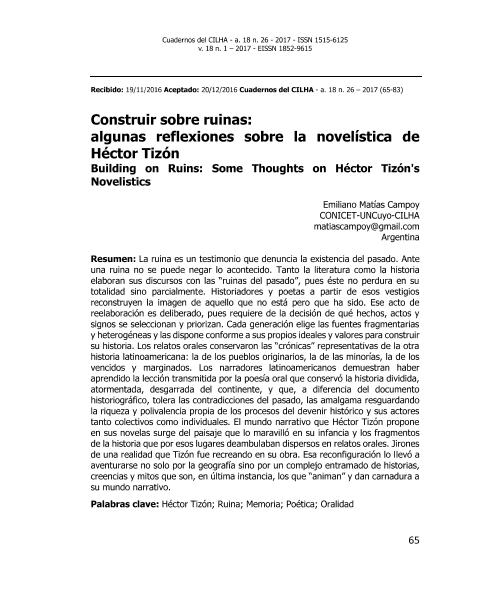Mostrar el registro sencillo del ítem
dc.contributor.author
Campoy, Emiliano Matías

dc.date.available
2019-07-30T18:38:18Z
dc.date.issued
2017-09
dc.identifier.citation
Campoy, Emiliano Matías; Construir sobre ruinas: algunas reflexiones sobre la novelística de Héctor Tizón; Universidad Nacional de Cuyo. Facultad de Filosofía y Letras; Cuadernos del CILHA; 18; 1; 9-2017; 65-83
dc.identifier.issn
1515-6125
dc.identifier.uri
http://hdl.handle.net/11336/80604
dc.description.abstract
La ruina es un testimonio que denuncia la existencia del pasado. Ante una ruina no se puede negar lo acontecido. Tanto la literatura como la historia elaboran sus discursos con las “ruinas del pasado”, pues éste no perdura en su totalidad sino parcialmente. Historiadores y poetas a partir de esos vestigios reconstruyen la imagen de aquello que no está pero que ha sido. Ese acto de reelaboración es deliberado, pues requiere de la decisión de qué hechos, actos y signos se seleccionan y priorizan. Cada generación elige las fuentes fragmentarias y heterogéneas y las dispone conforme a sus propios ideales y valores para construir su historia. Los relatos orales conservaron las “crónicas” representativas de la otra historia latinoamericana: la de los pueblos originarios, la de las minorías, la de los vencidos y marginados. Los narradores latinoamericanos demuestran haber aprendido la lección transmitida por la poesía oral que conservó la historia dividida, atormentada, desgarrada del continente, y que, a diferencia del documento historiográfico, tolera las contradicciones del pasado, las amalgama resguardando la riqueza y polivalencia propia de los procesos del devenir histórico y sus actores tanto colectivos como individuales. El mundo narrativo que Héctor Tizón propone en sus novelas surge del paisaje que lo maravilló en su infancia y los fragmentos de la historia que por esos lugares deambulaban dispersos en relatos orales. Jirones de una realidad que Tizón fue recreando en su obra. Esa reconfiguración lo llevó a aventurarse no solo por la geografía sino por un complejo entramado de historias, creencias y mitos que son, en última instancia, los que “animan” y dan carnadura a su mundo narrativo.
dc.description.abstract
Ruin is a testimony that denounces the existence of the past. Before a ruin cannot deny what happened. Both literature and history elaborate their speeches with the "ruins of the past," for it does not last in its entirety but only partially. Historians and poets from these vestiges reconstruct the image of that which is not but has been. That act of re-elaboration is deliberate, since it requires the decision of which facts, acts and signs are selected and prioritized. Each generation chooses the fragmented and heterogeneous sources and disposes them according to their own ideals and values to build their history. The oral histories retained the "chronicles" representative of the other Latin American history: that of the original peoples, that of the minorities, that of the vanquished and the marginalized. Latin American narrators show that they have learned the lesson transmitted by oral poetry that preserved the divided, tormented, torn history of the continent, and which, unlike the historiographical document, tolerates the contradictions of the past, amalgamating them with the wealth and versatility of the processes of the historical becoming and its actors both collective and individual. The narrative world that Héctor Tizón proposes in his novels arises from the landscape that marveled him in his childhood and the fragments of history that by these places wandered scattered in oral stories. Shreds of a reality that Tizón was recreating in his work. This reconfiguration led him to venture not only for geography but for a complex web of stories, beliefs and myths that are ultimately those who "encourage" and give way to his narrative world.
dc.format
application/pdf
dc.language.iso
spa
dc.publisher
Universidad Nacional de Cuyo. Facultad de Filosofía y Letras
dc.rights
info:eu-repo/semantics/openAccess
dc.rights.uri
https://creativecommons.org/licenses/by-nc-sa/2.5/ar/
dc.subject
Tizón
dc.subject
Ruina
dc.subject
Memoria
dc.subject
Poética
dc.subject.classification
Estudios Generales del Lenguaje

dc.subject.classification
Lengua y Literatura

dc.subject.classification
HUMANIDADES

dc.title
Construir sobre ruinas: algunas reflexiones sobre la novelística de Héctor Tizón
dc.type
info:eu-repo/semantics/article
dc.type
info:ar-repo/semantics/artículo
dc.type
info:eu-repo/semantics/publishedVersion
dc.date.updated
2019-05-23T18:46:32Z
dc.journal.volume
18
dc.journal.number
1
dc.journal.pagination
65-83
dc.journal.pais
Argentina

dc.journal.ciudad
Mendoza
dc.description.fil
Fil: Campoy, Emiliano Matías. Universidad Nacional de Cuyo. Facultad de Filosofía y Letras; Argentina. Consejo Nacional de Investigaciones Científicas y Técnicas. Centro Científico Tecnológico Conicet - Mendoza; Argentina
dc.journal.title
Cuadernos del CILHA
dc.relation.alternativeid
info:eu-repo/semantics/altIdentifier/url/http://revistas.uncuyo.edu.ar/ojs/index.php/cilha/article/view/1508
Archivos asociados
